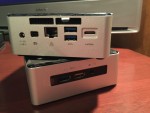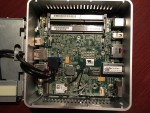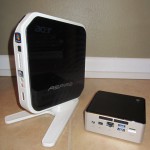 Hey, just so you know ... this post is now about 8 years and 8 months old. Please keep that in mind as it very well may contain broken links and/or outdated information.
Hey, just so you know ... this post is now about 8 years and 8 months old. Please keep that in mind as it very well may contain broken links and/or outdated information.Since getting my standing desk at home last last year I’ve been thinking about getting a new, smaller PC that would fit on top of my desk instead of under it (like my old Dell Inspiron from 2008), eliminating cable clutter. With the upcoming release of Windows 10 I had been thinking more about this and also replacing my Aspire Revo Linux server with a newer box. The nettop had the benefit of being small and quiet, although slightly underpowered, which made it a decent “server” to hide away in my networking closet. Using size, features, and cost as my guides, I decided to go with Intel NUCs for both replacements.
The NUC (Next Unit of Computing) platform is basically a 4x4x1 mini PC form-factor with a pre-installed CPU of your choice. You supply the desired amount of RAM (in two DDR3L SODIMM slots) and storage (M.2 SSD drive). I went with the RYH models (as opposed to RYK) that are an inch taller, allowing for a 2.5″ SATA3 drive. Additional specs include integrated Intel graphics, gigabit ethernet, wireless AC, mini HDMI and mini DisplayPort ports, 4 USB 3.0 ports (2 front/2 rear), and a headphone jack. There’s also a consumer IR sensor and VESA mounting plate (as these are meant to be used as media PCs mounted behind a television). If you need high-end gaming graphics, more drive bays, or ports, the NUC probably isn’t for you, but it turned out to be a perfect match for my needs.
For the Linux server, I went with the NUC5i5RYH (Intel Core i5, Intel HD Graphics 6000) and added 8gb of RAM and a 128gb M.2 SSD. I did a clean install of 64-bit Ubuntu 15.04 (Vivid Vervet) server and then manually re-installed and re-configured all of the packages I run (LAMP, Piwigo, Plex, WordPress (i.e., this blog!), Nagios, Calibre, UniFi, etc.), copied across the files I needed, etc. It took a few days, but once everything was complete I shut down the Revo and replaced it with the NUC. So far, so good! It’s a lot faster, quieter, and should use less power. Pluses all around.
My new daily-use home PC is now the NUC5i7RYH (Intel Core i7, Iris Graphics 6100). I put 16gb of RAM, went with a 250gb M.2 SSD, and also had to get mini HDMI-to-DVI and mini DisplayPort-to-DVI cables to connect my dual monitors plus an external CD/DVD drive, just in case. I then did a clean install of the latest final build of the Windows 10 Insider Preview (TH1 10240). The NUC sits nicely on top of my desk thus eliminating a bunch of cables running down to the floor. My only “complaint” is that since the single audio-out jack is on the front on the NUC, I have to have the speaker cable wrapping around to the front instead of keeping all of the cables go to the rear, which sorta ruins the clean look (see the photo below). That’s pretty minor though and overall I am pretty happy with the new setup.
- NUCs front and rear
- NUC internals
- Aspire Revo vs NUC
- NUC front audio cable




Funny … I specifically mentioned I got the RYH model to “allow for a 2.5″ SATA3 drive” and never actually put a 2.5″ drive in it (just the M.2 SSD). Anyway, I’ve now replaced the NUC as my desktop PC with the hp Spectre x360 16 laptop.